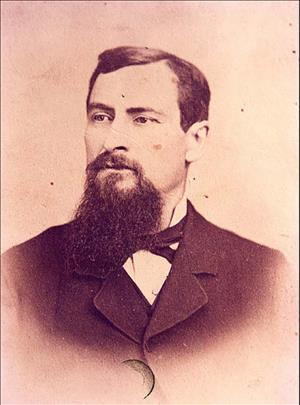On November 29, 1881, Spokane Falls, the forerunner of Spokane, is incorporated as a first-class city. From a tiny settlement established in 1871 along the falls of the Spokane River, the town has grown substantially by the time of incorporation. Estimates in published sources of the exact population vary widely, but the 1880 census lists 594 people, of whom more than 110 have Chinese names and are identified as servants. The precipitating factor in requesting incorporation, in addition to the rapid growth of the town, is the desire of local leaders to install a waterworks. Spokane Falls cannot grant such an authorization until it is incorporated.
Becoming a City
The Legislative Assembly of Washington Territory passed legislation on November 9, 1877, authorizing the incorporation of towns and cities within the territory. An act to incorporate Spokane passed the two houses of the legislature on November 22 and 25, 1881, and on November 29, 1881, William Augustus Newell (1817-1901), Washington Territorial governor, signed it into law. The original Act of Incorporation spelled the city’s name correctly, but the territorial printing office incorrectly spelled it as Spokan Falls, a phonetic spelling that was used elsewhere during the period, including on the 1880 census. This spelling was also used for Spokane’s first newspaper, the Spokan Times.
Incorporation of Spokane Falls called for the territorial legislature to appoint a mayor, councilmen, and a treasurer. These newly appointed officials were required to appoint a clerk and a marshal (or chief of police). The first mayor of Spokane Falls was Robert W. Forrest (1833-1892), who was elected in his own right during the first election in April 1882. The first councilmen were Samuel G. Havermale (1824-1904), council president; Anthony M. Cannon (1839-1895), treasurer; Louis H. Whitehouse, F. Rockwood Moore, Lorenzo Wesley "LW" Rima (1843-1885), George A. Davis, and William C. Gray, who became the city clerk. In the 1882 election, Havermale, Whitehouse, Davis, and Gray were returned to office. They were joined by new council members Samuel T. Arthur, G. G. Palmtag, and D. M. Drumheller. Canno, Moore, and Rima did not seek to be elected.
The first marshal (or chief of police) of Spokane Falls was Eugene B. Hyde, who served from 1881 to 1885. The mayor and councilmen were required to serve without pay, but hired professionals, such as the marshal, were to be paid. Incorporation also enabled the establishment of a fire department.
Lighting Streets, Barring Hogs, Regulating Bawdy Houses
Incorporation authorized the city to provide street lighting, cemeteries, infirmaries to isolate people with infectious diseases, workhouses, and jails, as well as to provide for a waterworks, and police and fire protection. The city could also levy taxes and assess fines, within certain limitations. Municipal indebtedness could not exceed $1,500.
Among the more curious provisions of the Act of Incorporation were preventing hogs and other livestock from running at large in the city; punishing people who used obscene language; regulation of the storage of combustibles; the licensing of saloons, hotels, restaurants, and theaters; and even the mandate to “license, regulate, or prohibit bawdy or whore houses in the city” (Act of Incorporation, Article 6, Section 1, provision 23).
Elections were to be held annually. In 1883, James M. Glover (1837-1921), known as the "father of Spokane," was elected mayor. Several others from the original council continued to serve, while the former mayor, Robert W. Forrest, became a councilman. Of these early municipal leaders, Havermale, Cannon, and Glover are perhaps the best remembered today.
The original incorporated town encompassed 1.56 square miles bounded by the Spokane River on the north, Cedar Street on the west, Hatch Street on the East, and 6th Avenue (with a jog onto 4th) on the south. In 1883 the legislature expanded the city limits to two square miles, which extended the north and south boundaries. At this time, the city was divided into four wards from which council members would be elected. This was the first of many annexations to the original city limits over the years.
The articles of incorporation were amended on November 28, 1883, to state: “The positions of city attorney, assessor, treasurer, and chief of police shall be elected by the qualified electors of said city ... .” (Bamonte, 5) Eugene B. Hyde was elected on April 1, 1884, thus continuing his tenure as marshal or chief of police.
The Railroad and the Fire
The seemingly momentous event of incorporation and the organization of municipal government was somewhat eclipsed by the fact that in June 1881, the first Northern Pacific Railway service had begun in Spokane Falls. For the merchants, farmers, and ordinary residents of the wider Spokane area, this event generated more excitement than the incorporation of the town. Yet both factors would have a major impact on the growth and prosperity of the city. In 1886, Spokane permanently regained from its rival, Cheney, the status of Spokane County seat.
By 1890, Spokane Falls was rapidly rebuilding after the disastrous fire of 1889. Amazingly, the population had risen to 20,000, thus enabling the city, under the laws of the new (1889) State of Washington, to adopt a charter. Freeholders were elected to draw up the document, which was completed on January 15, 1891. After publication in the newspapers for a period of time, it was submitted to the voters and approved by special election on March 24. Mayor Charles F. Clough affixed the corporate seal of the city of Spokane Falls to this charter on April 1, 1891. Although the charter itself says “The corporate name of the city is Spokane Falls, and by that name shall have perpetual succession” (Charter, Article I), the final article within the charter, voted on separately but at the same time, changed the name to Spokane. Interestingly, the majority for the name change was much smaller than for adoption of the charter.

